Abstract
We conducted a randomized controlled trial of a public health and education screening program aimed at all 4,797 four to five year old children registering for kindergarten in three school districts of southern Ontario, Canada. Children received either the Denver Developmental Screening Test (DDST) with a community health intervention program for positive screeness; the DDST with no intervention for positive screenees; or no screening test. The intervention program consisted of referral to the child's physician for assessment; a review conference between the child's teacher and the school health nurse; parent counseling; and monitoring of the child in school by the school health nurse. At the end of the third school year, no differences were found between positive screenees in the community health intervention group and the "no intervention" groups using individual academic achievement, cognitive, and developmental tests. Parents' reports revealed no differences between groups in children's mental, social, and behavioral well-being. However, parents of intervention program children had more worry about their child's school progress suggesting a potentially harmful labeling effect. In comparison to a random sample of children with normal DDST results, or a random sample of children who had randomly not been screened, the children with positive preschool DDSTs had substantially more school problems three years after screening.
Full text
PDF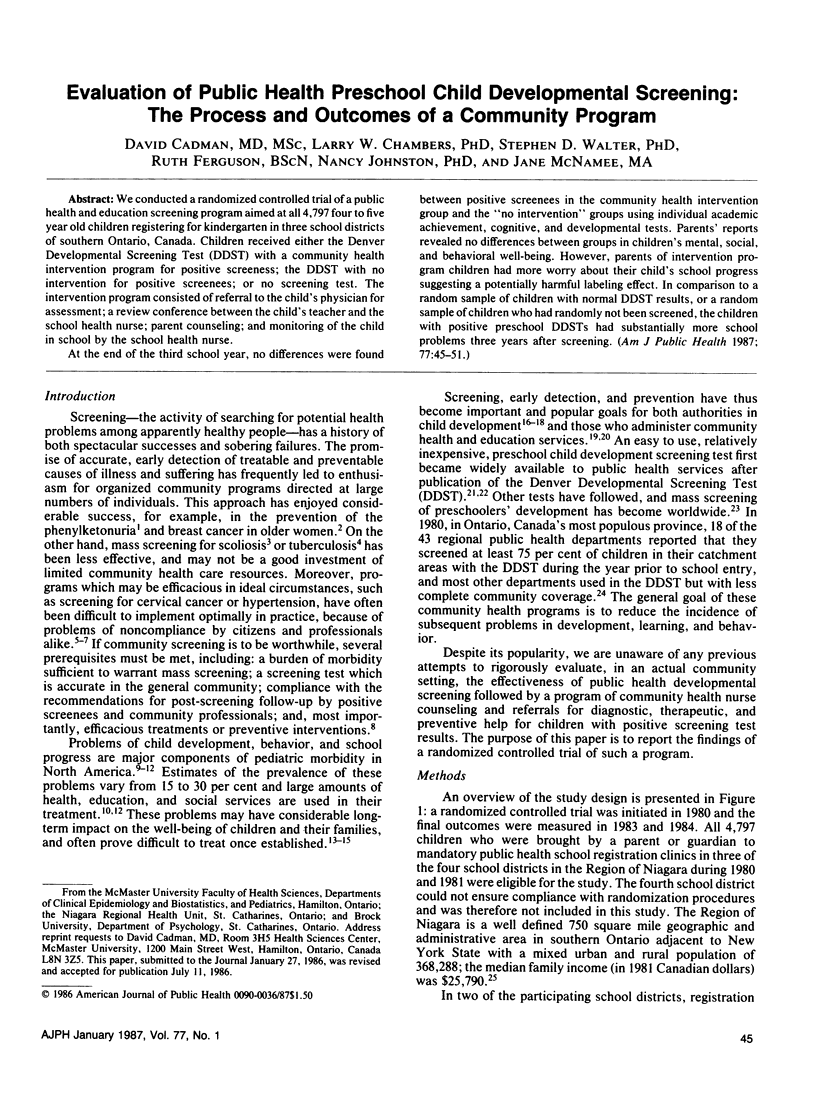
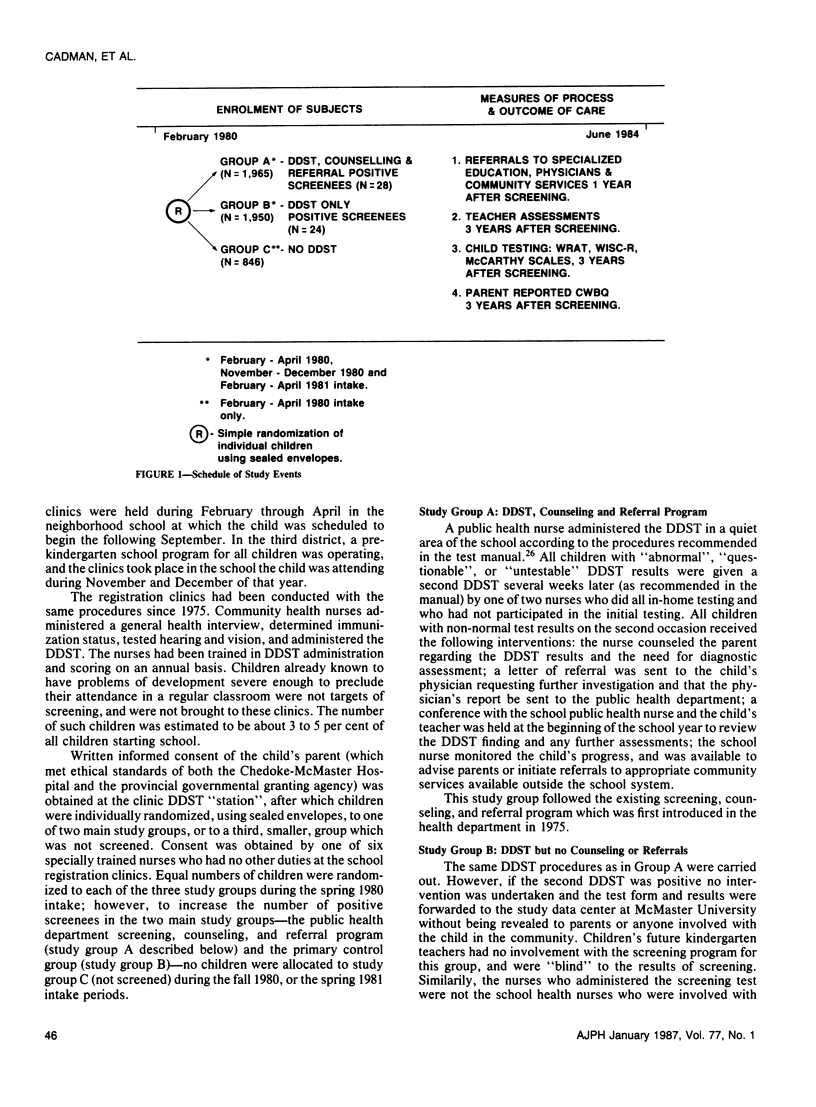
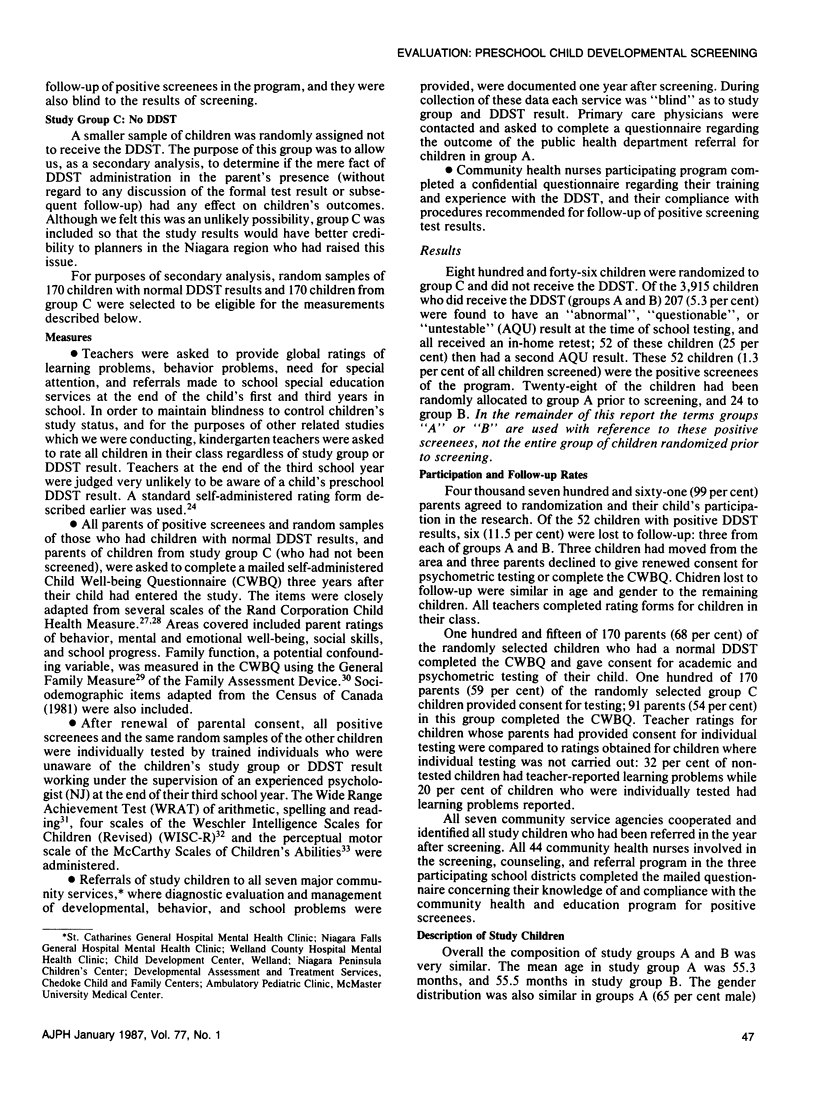
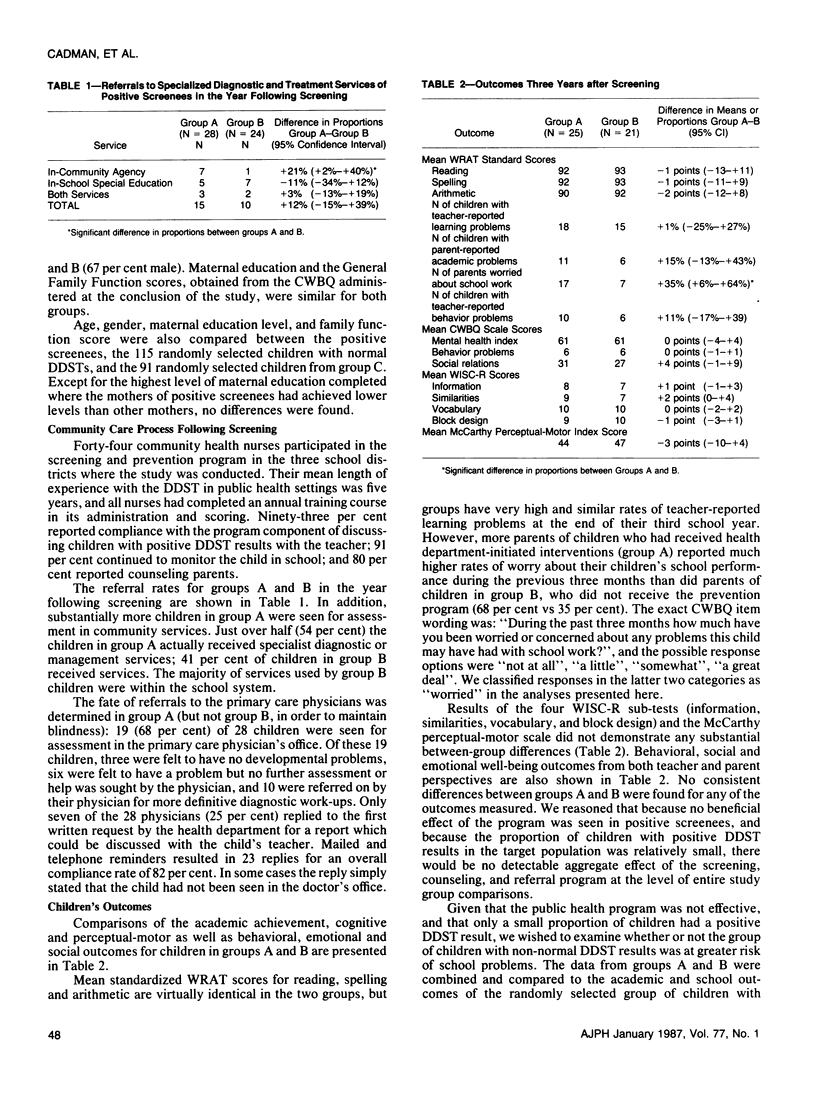
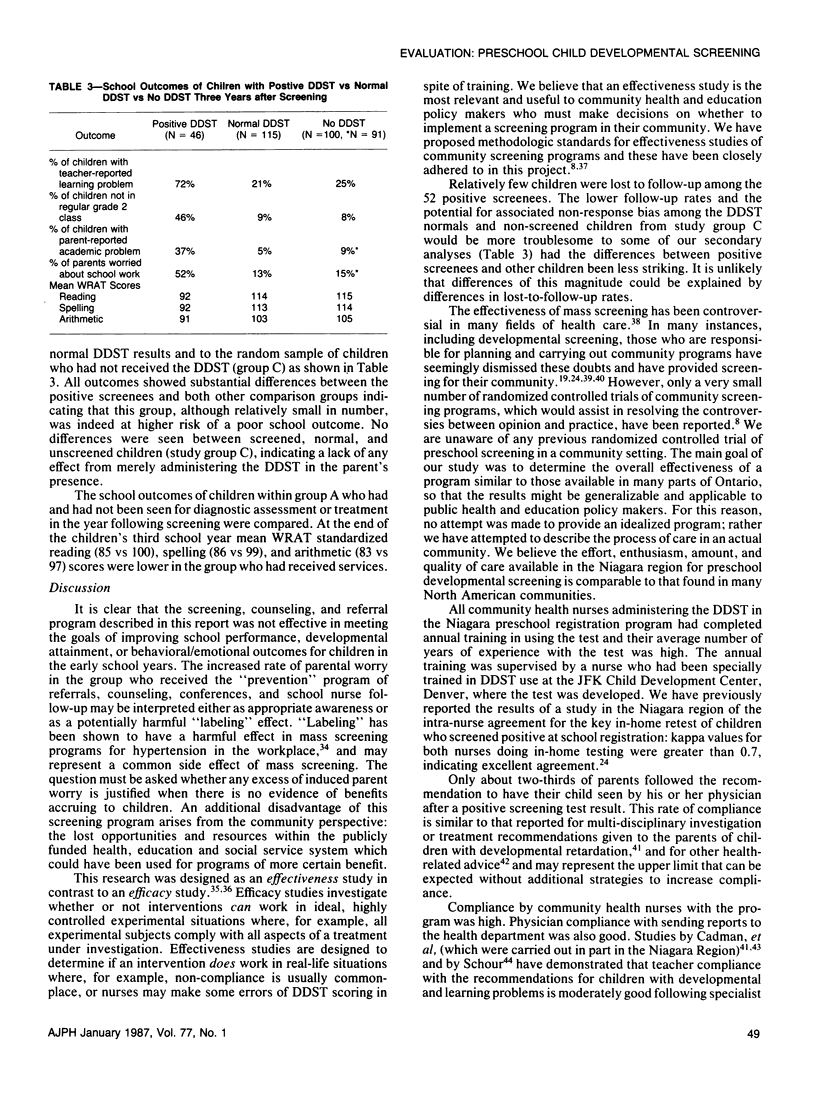
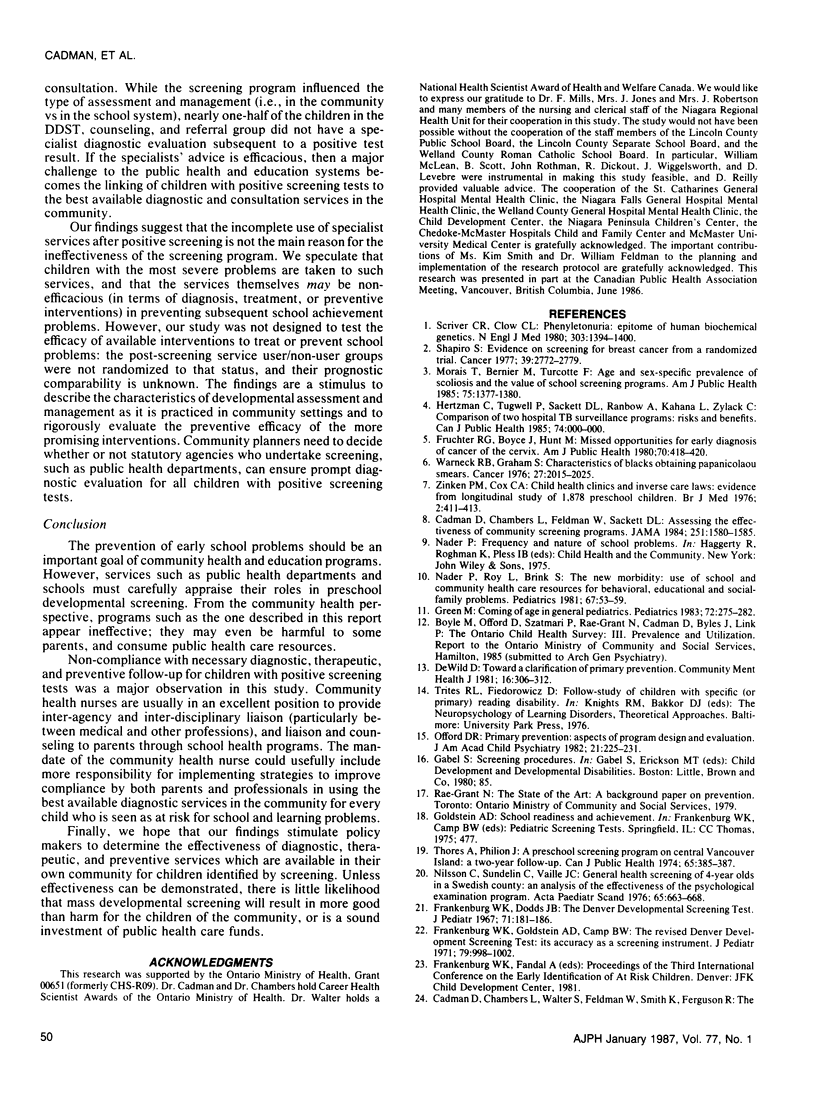
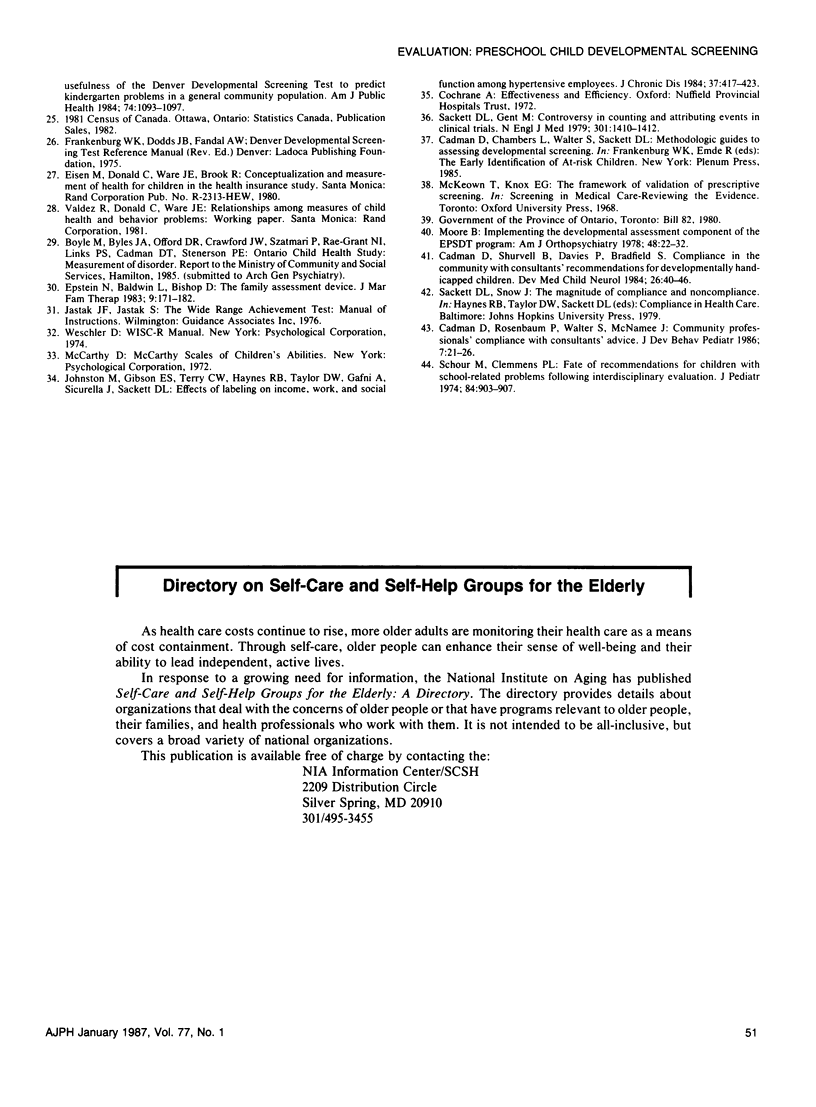
Selected References
These references are in PubMed. This may not be the complete list of references from this article.
- Cadman D., Chambers L., Feldman W., Sackett D. Assessing the effectiveness of community screening programs. JAMA. 1984 Mar 23;251(12):1580–1585. [PubMed] [Google Scholar]
- Cadman D., Rosenbaum P., Walter S., McNamee J. Community professionals' compliance with consultants' recommendations for developmentally disabled children. J Dev Behav Pediatr. 1986 Feb;7(1):21–26. doi: 10.1097/00004703-198602000-00004. [DOI] [PubMed] [Google Scholar]
- Cadman D., Shurvell B., Davies P., Bradfield S. Compliance in the community with consultants' recommendations for developmentally handicapped children. Dev Med Child Neurol. 1984 Feb;26(1):40–46. doi: 10.1111/j.1469-8749.1984.tb04404.x. [DOI] [PubMed] [Google Scholar]
- DeWild D. W. Toward a clarification of primary prevention. Community Ment Health J. 1980 Winter;16(4):306–316. doi: 10.1007/BF00821562. [DOI] [PubMed] [Google Scholar]
- Frankenburg W. K., Dodds J. B. The Denver developmental screening test. J Pediatr. 1967 Aug;71(2):181–191. doi: 10.1016/s0022-3476(67)80070-2. [DOI] [PubMed] [Google Scholar]
- Fruchter R. G., Boyce J., Hunt M. Missed opportunities for early diagnosis of cancer of the cervix. Am J Public Health. 1980 Apr;70(4):418–420. doi: 10.2105/ajph.70.4.418. [DOI] [PMC free article] [PubMed] [Google Scholar]
- Green M. Coming of age in general pediatrics. Pediatrics. 1983 Sep;72(3):275–282. [PubMed] [Google Scholar]
- Johnston M. E., Gibson E. S., Terry C. W., Haynes R. B., Taylor D. W., Gafni A., Sicurella J. I., Sackett D. L. Effects of labelling on income, work and social function among hypertensive employees. J Chronic Dis. 1984;37(6):417–423. doi: 10.1016/0021-9681(84)90025-0. [DOI] [PubMed] [Google Scholar]
- Moore B. D. Implementing the developmental assessment component of the EPSDT program. Am J Orthopsychiatry. 1978 Jan;48(1):22–32. doi: 10.1111/j.1939-0025.1978.tb01286.x. [DOI] [PubMed] [Google Scholar]
- Morais T., Bernier M., Turcotte F. Age- and sex-specific prevalence of scoliosis and the value of school screening programs. Am J Public Health. 1985 Dec;75(12):1377–1380. doi: 10.2105/ajph.75.12.1377. [DOI] [PMC free article] [PubMed] [Google Scholar]
- Nader P. R., Ray L., Brink S. The new morbidity: use of school and community health care resources for behavioral, educational, and social-family problems. Pediatrics. 1981 Jan;67(1):53–60. [PubMed] [Google Scholar]
- Nilsson C., Sundelin C., Vuille J. C. General health screening of four-year-olds in a Swedish county. IV. An analysis of the effectiveness of the psychological examination program. Acta Paediatr Scand. 1976 Nov;65(6):663–668. doi: 10.1111/j.1651-2227.1976.tb17999.x. [DOI] [PubMed] [Google Scholar]
- Offord D. R. Primary prevention: aspects of program design and evaluation. J Am Acad Child Psychiatry. 1982 May;21(3):225–230. doi: 10.1016/s0002-7138(09)60874-8. [DOI] [PubMed] [Google Scholar]
- Sackett D. L., Gent M. Controversy in counting and attributing events in clinical trials. N Engl J Med. 1979 Dec 27;301(26):1410–1412. doi: 10.1056/NEJM197912273012602. [DOI] [PubMed] [Google Scholar]
- Schour M., Clemmens R. L. Fate of recommendations for children with school-related problems following interdisciplinary evaluation. J Pediatr. 1974 Jun;84(6):903–907. doi: 10.1016/s0022-3476(74)80779-1. [DOI] [PubMed] [Google Scholar]
- Scriver C. R., Clow C. L. Phenylketonuria: epitome of human biochemical genetics (second of two parts). N Engl J Med. 1980 Dec 11;303(24):1394–1400. doi: 10.1056/NEJM198012113032404. [DOI] [PubMed] [Google Scholar]
- Shapiro S. Evidence on screening for breast cancer from a randomized trial. Cancer. 1977 Jun;39(6 Suppl):2772–2782. doi: 10.1002/1097-0142(197706)39:6<2772::aid-cncr2820390665>3.0.co;2-k. [DOI] [PubMed] [Google Scholar]
- Thores A., Philion J. A preschool screening program on central Vancouver Island: a two-year follow-up. Can J Public Health. 1974 Sep-Oct;65(5):385–387. [PubMed] [Google Scholar]
- Warnecke R. B., Graham S. Characteristics of blacks obtaining Papanicolaou smears. Cancer. 1976 Apr;37(4):2015–2025. doi: 10.1002/1097-0142(197604)37:4<2015::aid-cncr2820370453>3.0.co;2-x. [DOI] [PubMed] [Google Scholar]
- Zinkin P. M., Cox C. A. Child health clincs and inverse care laws: evidence from longitudinal study of 1878 pre-school children. Br Med J. 1976 Aug 14;2(6032):411–413. doi: 10.1136/bmj.2.6032.411. [DOI] [PMC free article] [PubMed] [Google Scholar]


